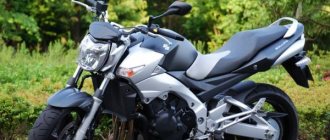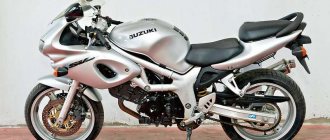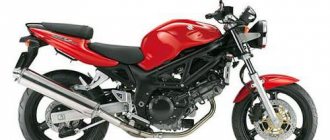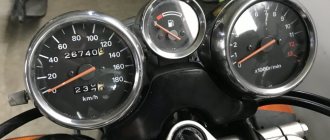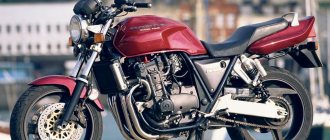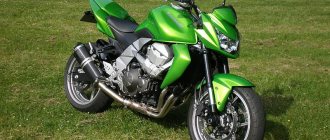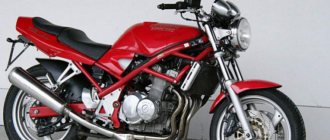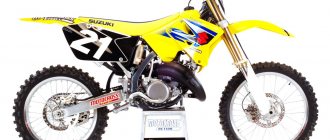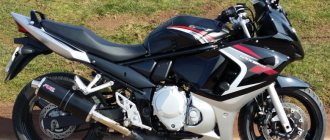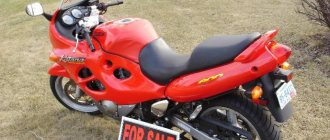Review of the Suzuki GSF 650 Bandit motorcycle
The motorcycle after the sports tourist is very comfortable, the landing is straight and not at all stressful, although my height is 186 and my weight is over a hundred. The pendants are a little soft, but it doesn’t bother me; I’ve gotten used to them a long time ago. Only in aggressive turns is the rear a little unstable (swings) (the shock absorbers, of course, are in good working order). Regarding the power: it’s absolutely enough for me, I catch myself thinking that I don’t really need a liter, even though I drive fast. It’s convenient to move through traffic jams, no problems. It may be good that there is no draft at the bottom, but you can drive between cars very accurately, without fear of accidentally pulling the throttle (in my case, nothing criminal will happen). I don’t see much point in writing about what exactly I replaced from spare parts, because... The condition of all motorcycles is completely different. I’ll just say that I don’t regret money, I serve as expected. Over the course of two years, I spent approximately 60,000 rubles on spare parts and maintenance. I just can’t get the engine to work perfectly in all modes. Either there is a failure when starting, then there are jerks at high speeds. Naturally, I changed the spark plugs and cleaned the carbs. With varying success in general.
In Moscow traffic jams it behaves well, maneuverable, excellent mobility. The steering wheel is not wide, which is also a plus. Everyone buys a motorcycle for themselves and to solve their problems. I had a goal - to travel. He copes with it with a bang. I went on long-distance trips a couple of times, the case was in the back, on the sides, the bag was on the tank, I consider it to be quite load-bearing, since it did not affect the speed. I will note one inconvenience, this is the location of the spark plugs (under the tank), I did not change it myself, I gave it to my friends for service. The rear spring is in the middle position, which is how I bought it. It's not much fun to drive off-road, especially on sand, although you can pull it off even on it. In strong winds, sometimes you have to taxi. The overclocking characteristics suit me. At one time it accelerates to 180 km/h. It’s convenient that there is a central stand, which is perfect for servicing it. My consumption is about 5 liters per 100 km. The injector never failed, even after winter we started easily. And I’m very pleased that I have him with abs.
After 400, of course, the power reserve felt very decent. He seemed heavier, more powerful, and taller to me. Good acceleration, clear gearbox movements, everything is normal. Fuel consumption is somewhere from 7 to 9 liters in the city (if you don’t stand), and 6 liters on the highway, well, maybe less. Yes, the version with abs, I haven’t had to use it yet. I would like there to be an indication of the gear being engaged, because sometimes I get into 6th and then try to put it in 6th again, because... I forget about her. And some semblance of an on-board computer would be useful... I agree with the people’s opinion about the muffler - it’s really very quiet, they don’t notice me and almost don’t hear me. Whether it’s my friend on the boulevard 1.5 liter with a cobra!!! whoever knows will understand what I mean. With number two we accelerated to 220 km/h, although not for long, we probably drove like that for about 10 seconds, after all, we don’t ride on European highways. Well, it was all show-off, of course, before number 2; in normal life I don’t drive more than 150. Overall a very balanced motorcycle.
Specifications
The first generation engine (2005–2006) is carburetor with air-oil cooling.
As before, the engine is based on the sports model GSX-R .
The experience of the 600 also played a role - the traction adjustment is made in such a way that the bike rides equally well at any speed. Users note a slight dip in the mid-range, but many carburetor motorcycles suffer from this “disease.”
Installing an injector in the second generation solved this problem. Otherwise it was a pretty standard engine:
- working volume - 656 cm3;
- number of cylinders - 4, in-line arrangement;
- number of cycles - 4;
- number of valves - 16, 4 per cylinder;
- power - 78 (86) hp;
- torque - 59 (62) Nm;
- cooling - air (liquid);
First generation engine oil cooler.
- fuel supply - Keihin 4x carburetor (injector + SDTV);
- ignition - transistor, TDI;
- start - electric starter;
- tank volume - 20 (18) l.
Values after restyling in 2007 are indicated in parentheses. It can also be noted that the new engine met EURO-3 .
The second generation engine (since 2007) is injection and liquid cooled.
It is curious that according to the developers, the fuel tank has not been changed; it still “holds” 20 liters . But at the same time they “forgot” to indicate that the presence of a submersible pump, which appeared in the new version, reduces the useful volume by 2 liters .
Transmission and clutch
The main drive is a classic chain drive.
The motorcycle was equipped with a 6-speed gearbox.
The travel of the shift pedal is within normal limits, but users noted that even though the numbers are “almost close,” it is comfortable to drive both in sixth and first. “You need to switch so rarely that sometimes you forget which stage you have on.”
Restyling 2007 did not change the clutch.
- It remained multi-disc, in an oil bath . But the transmission of force has become different. hydraulics appeared .
- They did not touch the main drive - the chain .
Brakes
Front brakes.
Rear brakes.
But the changes had an impressive impact on the brake discs.
Front: brakes:
- number of disks - 2;
- diameter - 290 (310) mm;
- support - 2x (4) piston.
Rear brakes:
- number of disks - 1;
- diameter - 240 mm;
- support - 2-piston.
And ABS was also offered as an option . True, it was not included in the stock package. Installation was offered only in authorized brand showrooms. You could choose whether to put it on the front or not. It was always placed on the back.
It is curious that during further work on the 750 cc version, the changes were abandoned.
Modifications and competitors
In 2008, parallel to the bandit, the production of the Suzuki GSX650F began, positioned as a sports tourer.
The sports version was easily recognizable by its front fairing.
Essentially, it remains the same motorcycle, completely encased in plastic. But by definition it could not become a complete analogue, since it itself was the successor to the previously produced “katana” - Suzuki GSX600F Katana . It received a large number of features that the second generation bandit 650 possessed - injector , Euro-3 , SDTV . Since it was originally equipped with a fairing, it had increased weight. Its average characteristics have earned it popularity among beginners. The motorcycle did not undergo significant changes, and lived in production for a year longer than its “brother”. In 2016, the last “tourist” leaves for Europe.
Honda
Honda was skeptical about the competitor's bike, providing three models for comparison.
- Honda CB650F is a naked bike, has its own fuel supply system, and is lighter. The user is offered ABS as stock. The motorcycle loses a little in terms of engine capacity ( 649 ), but this does not prevent it from developing a power of 89 horses and having a torque of 64 Nm . Production continues.
- Honda CBR650F is a derivative of the first. Steering wheel replaced. Since the model is positioned as a sport, clip-ons are installed. Otherwise everything is identical. The release continues.
- Honda CBF600 was also a naked bike. 599 cc engine produced 77 horsepower and 59 Nm of torque. The highlight of the model was the presence of combi-breaks - turning on the rear when engaging the front (ABS in stock) and frame and aluminum - from the second generation. The model closed in 2013 .
Honda CB650F.
Honda CBF600.
Honda CBR650F.
To be fair, it is worth noting that the first two appeared on the market after the third one closed. Therefore, Suzuki fans do not need to focus on the number three.
Yamaha XJ6 Diversion
The Yamaha XJ6 Diversion road bike model appeared on the market in 2009.
Yamaxa also presented its analogue. It was the Yamaha XJ6 Diversion, based on the Fazer 600 . In terms of its performance characteristics, the model exactly repeated the Honda CBF 600 , only the declared maximum speed was higher and the tank was smaller. It remained on the assembly line until 2017 .
Kawasaki ER-6
Kawasaki's ER-6 series of road bikes was first introduced in 2006.
Kawasaki did not stand aside either. A couple of years later they announced the Kawasaki ER-6 model. Aka Kawasaki ER-6n, Kawasaki ER-6f, Kawasaki Ninja 650R. The main difference was the 2-cylinder (versus 4 for all of the above and Suzuki). The volume of 649 cubic meters gave 72 hp. power and 64 Nm of torque. It also had the smallest gas tank among competitors - only 15 liters . The total consumption was 4.5-5.5 liters . The model closed in 2021.
Flaws
Users do not find any disadvantages in operation. But there is a problem with maintenance : the spark plugs are inconveniently located , even though they are located under the gas tank - you have to disassemble half the bike to get there.
and dignity
The motorcycle accelerates easily, maneuvers confidently and brakes effectively - exactly what you need for moving along city streets.
- Pendant . It’s short like the rest of the line, but quite flexible, given that you can customize the progression of the pendulum yourself.
- Cold start . Of course, with disadvantages there may be problems, but the second generation injector is able to minimize them.
- Power reserve . Even at 200 km it feels like the bike can do more.
- Big tank . With low consumption, a reserve of 18–19 ° allows you to travel 300 km or more on 1 refill.
- Dynamics, handling, dimensions . Ideal for “cross-row shooting”
- Good checkpoint . “Scooter” Set the gear, and then use the throttle.
Quiet exhaust is both a plus and a minus. On the one hand, it doesn’t bother you on long trips, on the other hand, the “boxers” notice when you drive through them
Brief history of the model
2005 - start of production and sales. First generation. Model: Suzuki GSF650 Bandit + ABS; Suzuki GSF650S Bandit + ABS (Europe, North America). Factory designation: GSF650K5 + GSF650AK5; GSF650SK5 + GSF650SAK5.
2006 - no significant changes. Model: Suzuki GSF650 Bandit + ABS; Suzuki GSF650S Bandit + ABS (Europe, North America). Factory designation: GSF650K6 + GSF650AK6; GSF650SK6 + GSF650SAK6.
2007 - restyling of the model. Second generation. The model receives an updated appearance, a new liquid-cooled engine (complies with Euro-3 standards), electronic fuel injection with dual throttle valves (SDTV), an extended swingarm and a stiffer frame (by 10%), 310 mm brake discs with 4-piston calipers , hydraulic clutch, fuel tank with a capacity of 19 l. Maximum power increases to 85 hp, torque - to 62 Nm. The gearbox ratios change slightly. Model: Suzuki GSF650 Bandit + ABS; Suzuki GSF650S Bandit + ABS (Europe, North America, Australia, Brazil). Factory designation: GSF650K7 + GSF650AK7; GSF650SK7 + GSF650SAK7.
2008 - no significant changes. Model: Suzuki GSF650 Bandit + ABS; Suzuki GSF650S Bandit + ABS (Europe, North America, Australia, Brazil). Factory designation: GSF650K8 + GSF650AK8; GSF650SK8 + GSF650SAK8.
2009 - restyling of the model. Third generation. The model receives minor changes in appearance regarding the dashboard, headlight (in the naked version) and exhaust system design. This generation is distinguished by a black engine. Model: Suzuki GSF650 Bandit + ABS; Suzuki GSF650S Bandit + ABS (Europe, North America, Australia, Brazil). Factory designation: GSF650K9 + GSF650AK9; GSF650SK9 + GSF650SAK9.
2010 - no significant changes. Model: Suzuki GSF650 Bandit + ABS; Suzuki GSF650S Bandit + ABS (Europe, North America, Australia, Brazil). Factory designation: GSF650L0 + GSF650AL0; GSF650SL0 + GSF650SAL0.
2011 - no significant changes. Model: Suzuki GSF650 Bandit + ABS; Suzuki GSF650S Bandit + ABS (Europe, North America, Australia, Brazil). Factory designation: GSF650L1 + GSF650AL1; GSF650SL1 + GSF650SAL1.
2012 is the last year of production of the naked version. Model: Suzuki GSF650 Bandit + ABS; Suzuki GSF650S Bandit + ABS (Europe, North America, Australia, Brazil). Factory designation: GSF650L2 + GSF650AL2; GSF650SL2 + GSF650SAL2.
2013 - no significant changes. Model: Suzuki GSF650S Bandit + ABS (Europe, North America, Australia, Brazil). Factory designation: GSF650SL3 + GSF650SAL3.
2014 - no significant changes. Model: Suzuki GSF650S Bandit + ABS (Europe, North America, Australia, Brazil). Factory designation: GSF650SL4 + GSF650SAL4.
2015 is the last year of production. Model: Suzuki GSF650S Bandit + ABS (Europe, North America, Australia, Brazil). Factory designation: GSF650SL5 + GSF650SAL5.
Dimensions and weight
Among his classmates, “Bandit” is considered a heavyweight.
According to reviews, the bike is quite heavy, but this does not affect the handling. Even a biker girl can roll out, pushing off with her feet, out of a garage or from a parking lot on the side of the road.
- Dry weight - 215 kg .
- Equipped, including tank and all liquids - 240 kg .
It is worth noting that the fairing adds 7 kg of weight, installing ABS up to 10 kg .
Second generation
After restyling, the model receives a new engine, an extended swingarm and a more rigid frame.
The second generation was also reflected in the dimensions of the model. In all dimensions the bike has grown:
- in length - from 2,110 to 2,130 mm;
- width - from 770 to 780 mm;
- in height - from 1,085 to 1,095 mm (the version with a fairing - 1,225 mm , remained the same for the entire production period);
Saddle height - 770-790 mm (did not change, but could be changed to suit the owner’s height).
Wheelbase - from 1440 to 1470 mm.
Ground clearance - from 130 to 135 mm.
Front optics of the first and second generation.
Third generation front optics (since 2009).
For whom is it intended?
The line of bandits was developed for export, so all parameters were calculated for the height of the average European (including a resident of Russia).
Despite the rather low seating position, short users could adjust the height of the handlebars and saddle on their own.
